Abstract
The authors first review the doses and cycles of application normally recommended in different parts of the world for DDT, BHC, and dieldrin in controlling malaria, and then discuss the experimental evidence concerning their actual efficacy in the field. The irritant effect of the various insecticides is compared, DDT being found the most irritant and dieldrin the least. BHC appears to be highly irritant when solid, but not when vaporized. The problem of the application of residual insecticides to absorbent surfaces, such as mud, is considered; the wettable powders are generally accepted as the most efficient formulation for such surfaces, but even with these a marked loss in toxicity may occur, requiring higher initial doses and more frequent application than on non-absorbent surfaces. With volatile insecticides, such as BHC, some degree of absorption slows down the loss by volatilization, but at the usual field dosages of 0.1 g and 0.2 g of gamma-BHC per m2 the decline in toxicity is still rapid. Experiments have also shown that mixtures of DDT and BHC may, in some circumstances, combine the initial high kill of the latter with the persistent moderate kill of the former.
Considering the insecticidal efficiency needed for the control of malaria, the authors find that most natural circumstances would be met by attaining a mortality-rate of about 65% of mosquitos entering treated shelters; 85% mortality would be suitable for the most severe conditions and 65% mortality for controlling moderate transmission by endophilic mosquitos.
Full text
PDF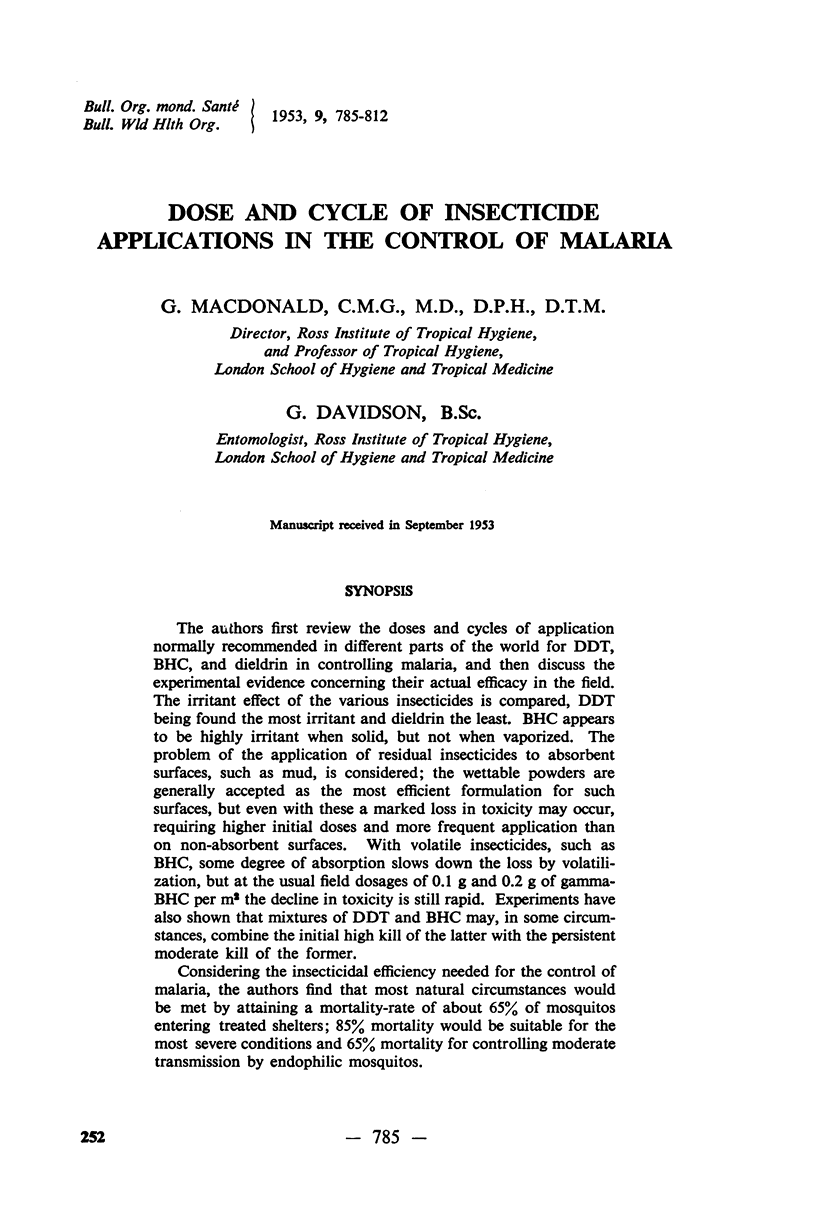
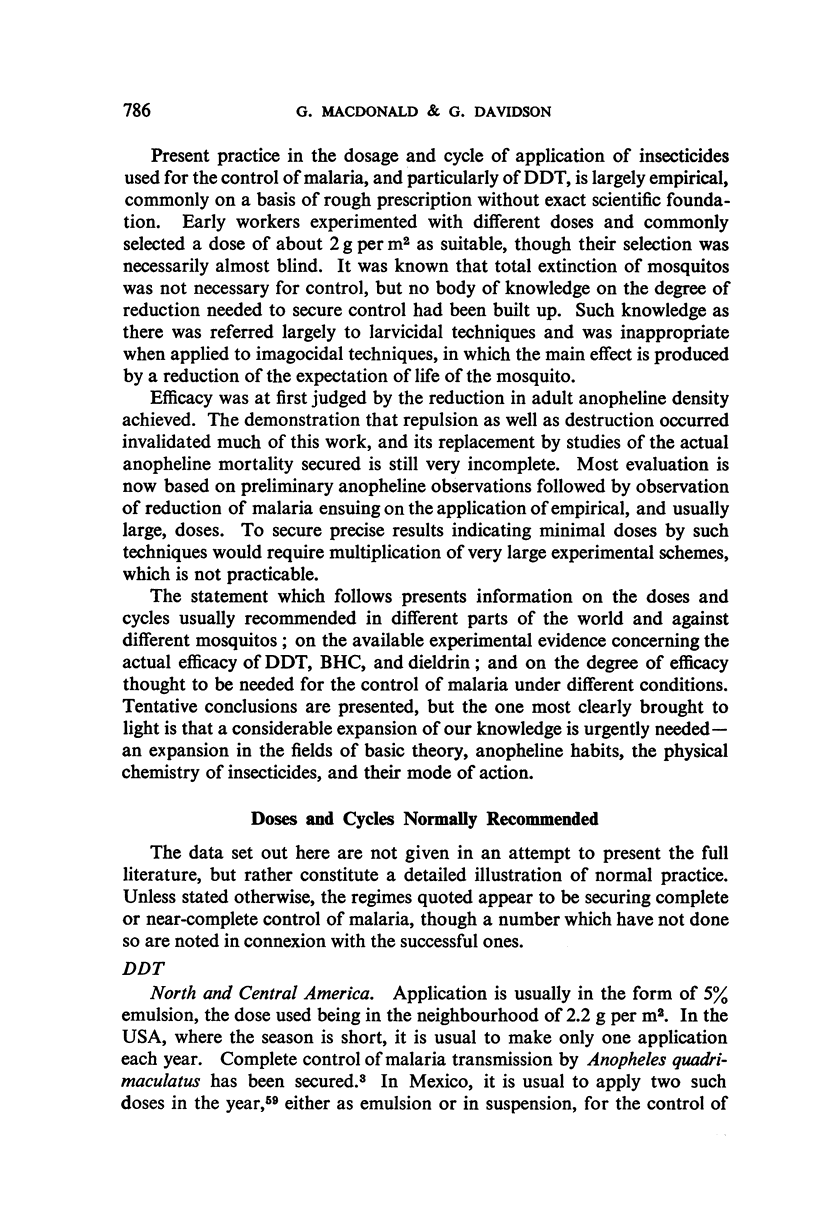
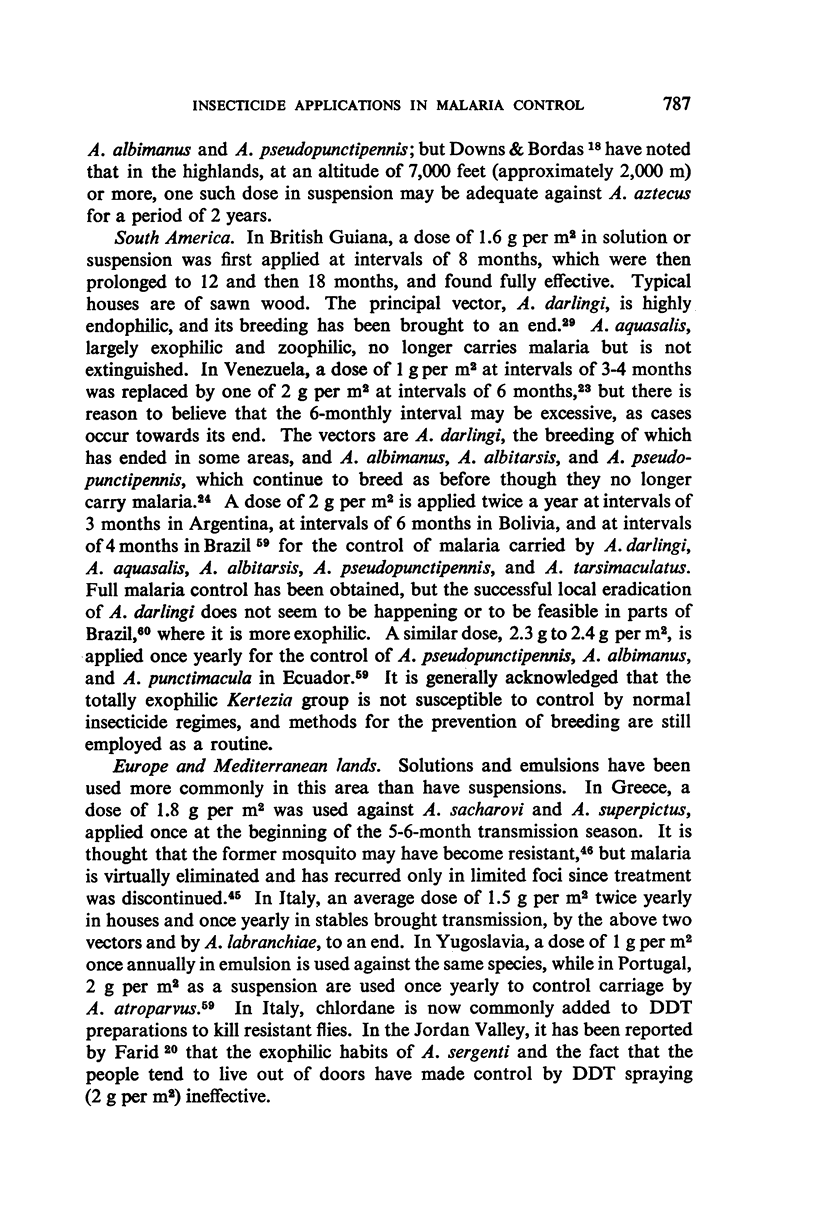
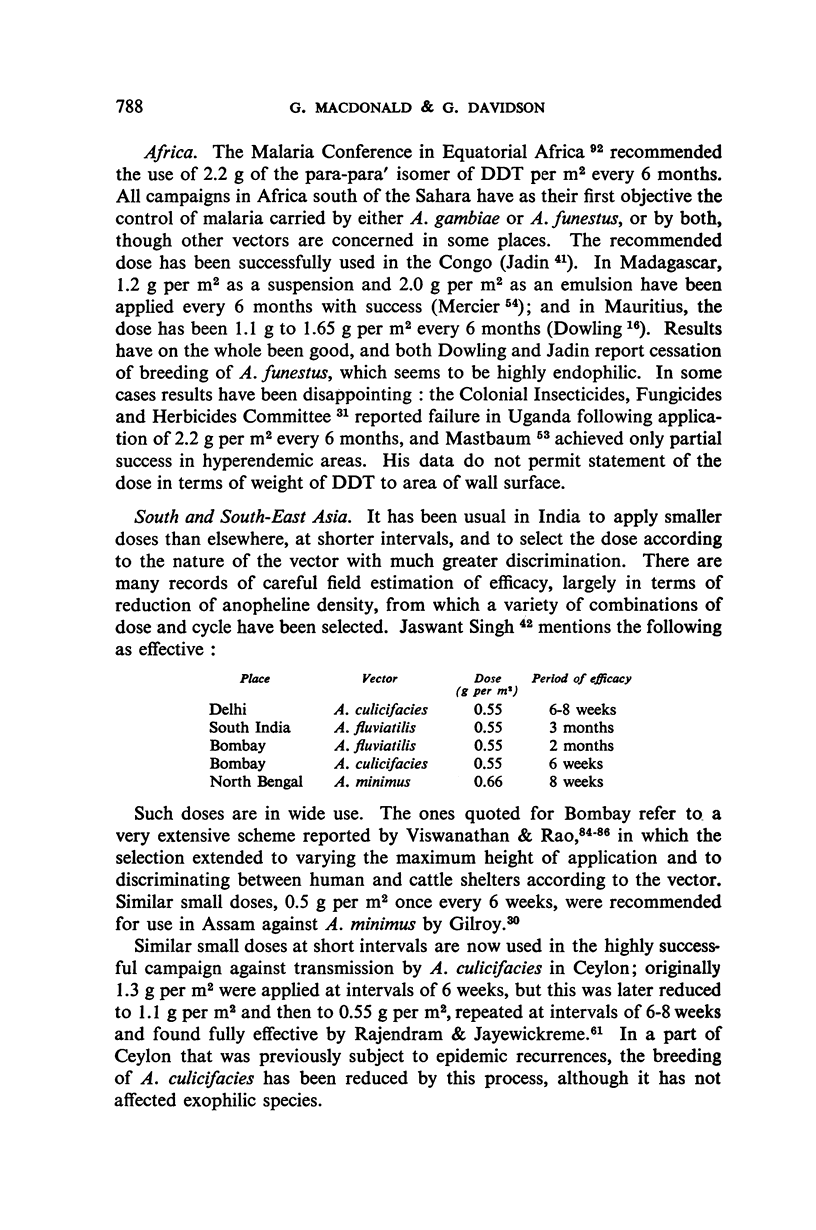
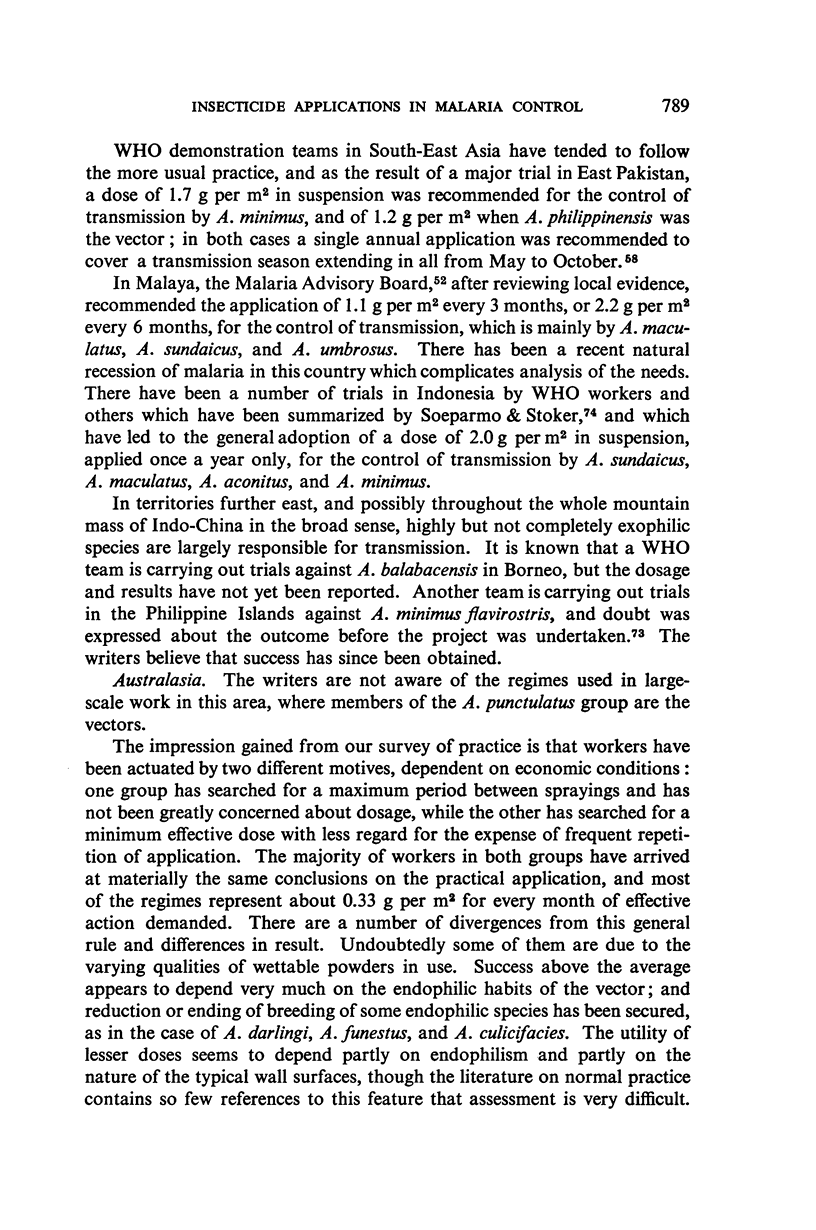
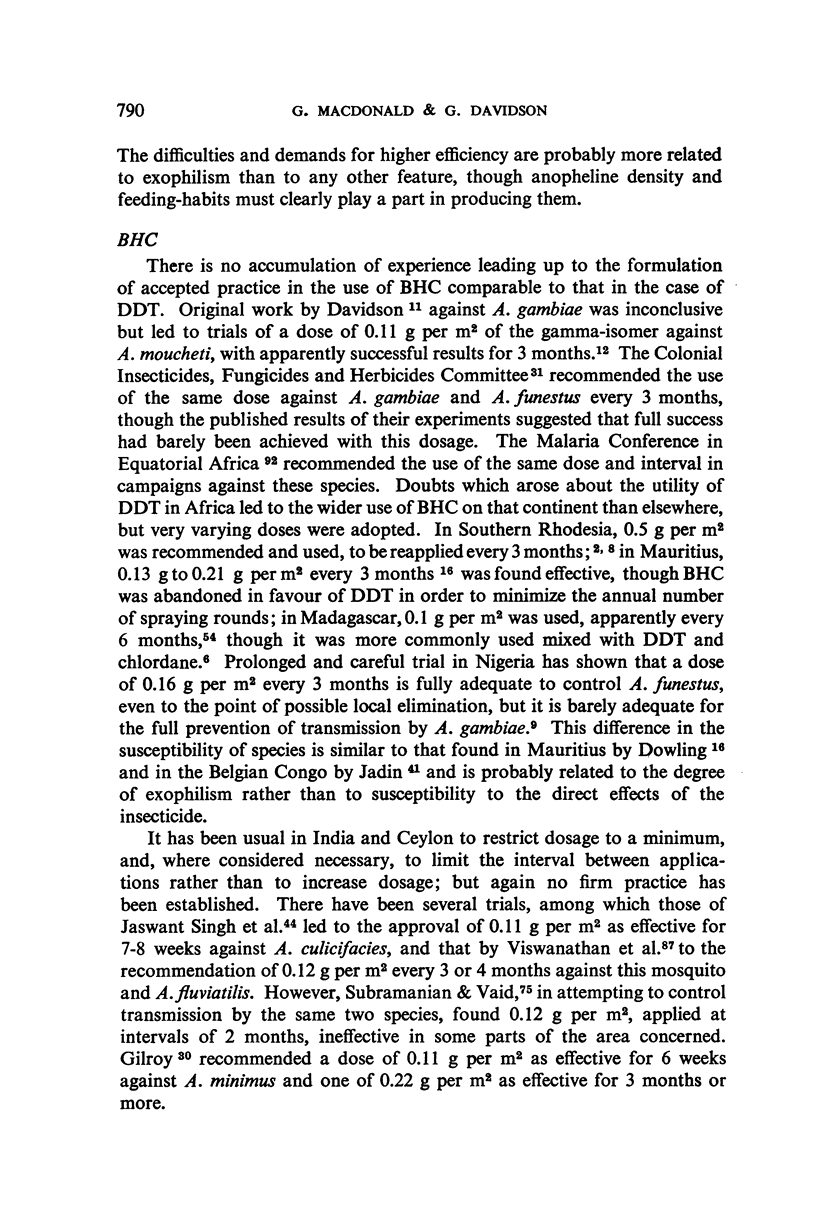
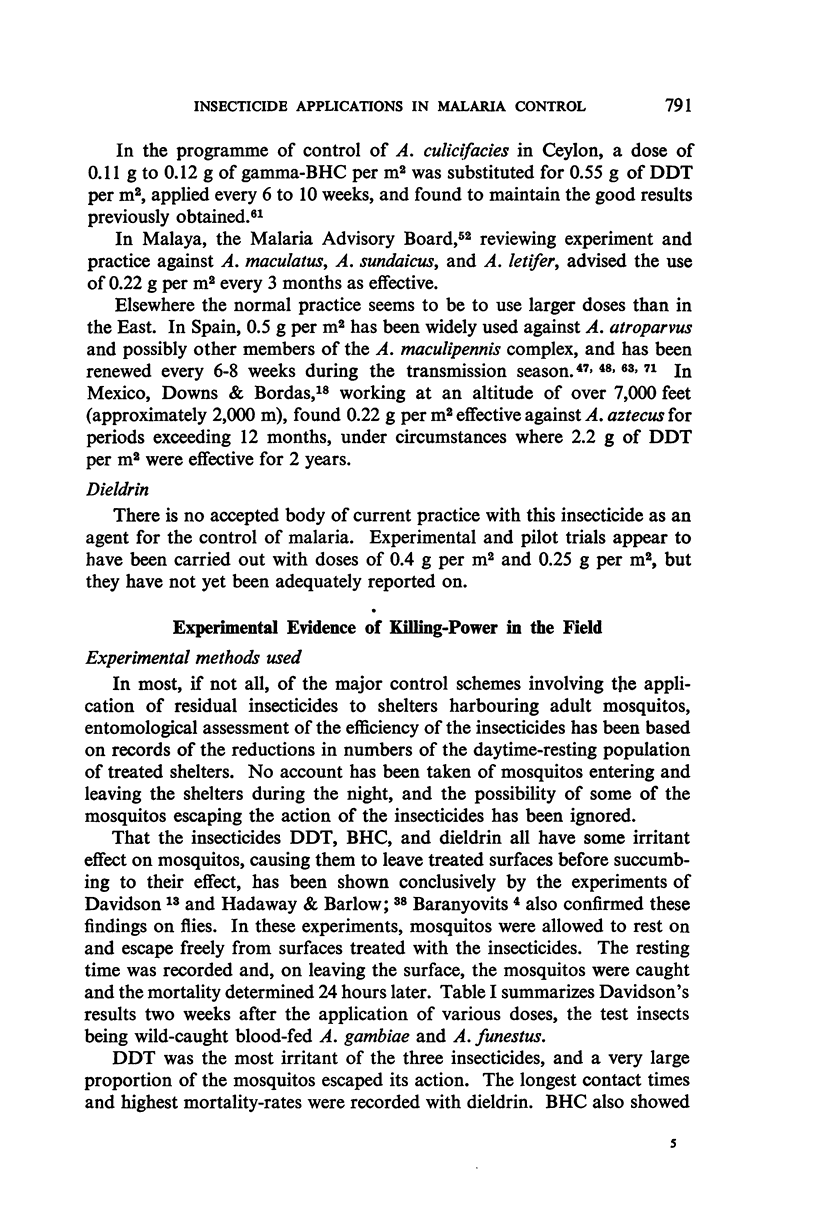
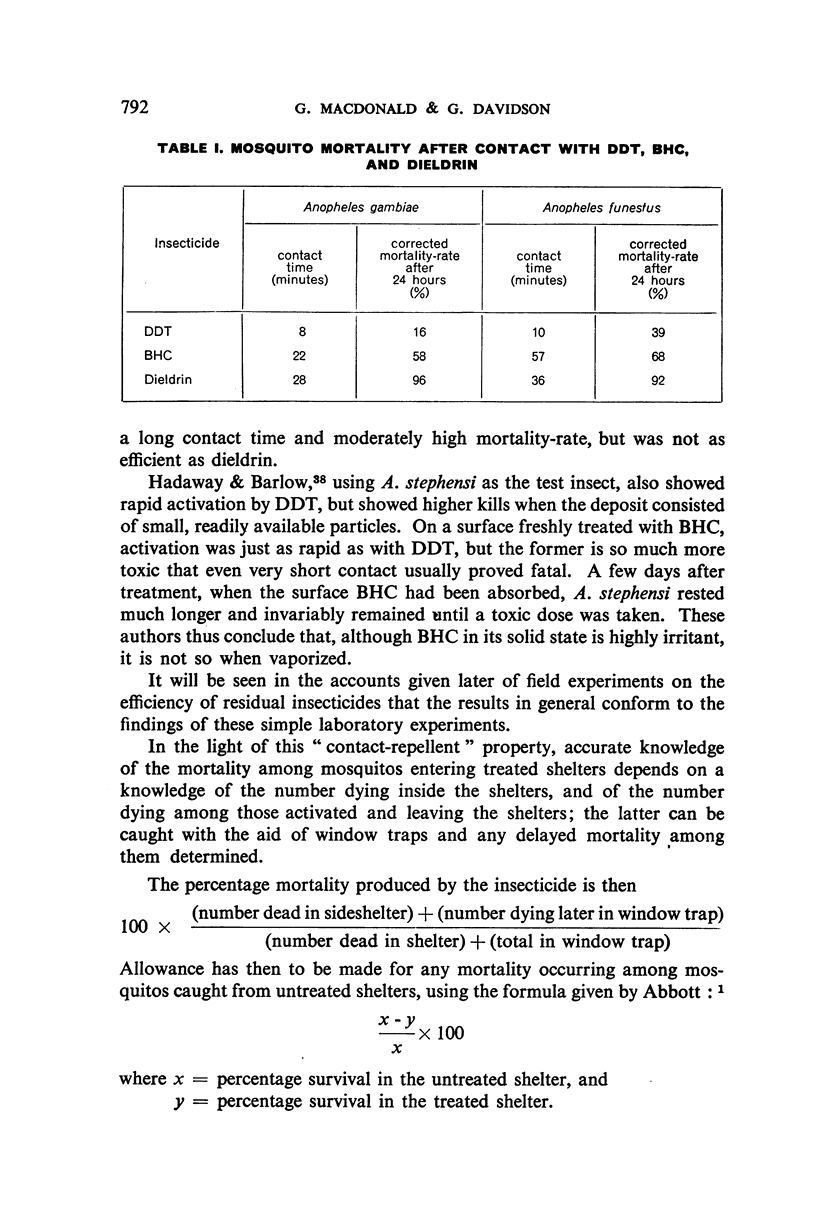
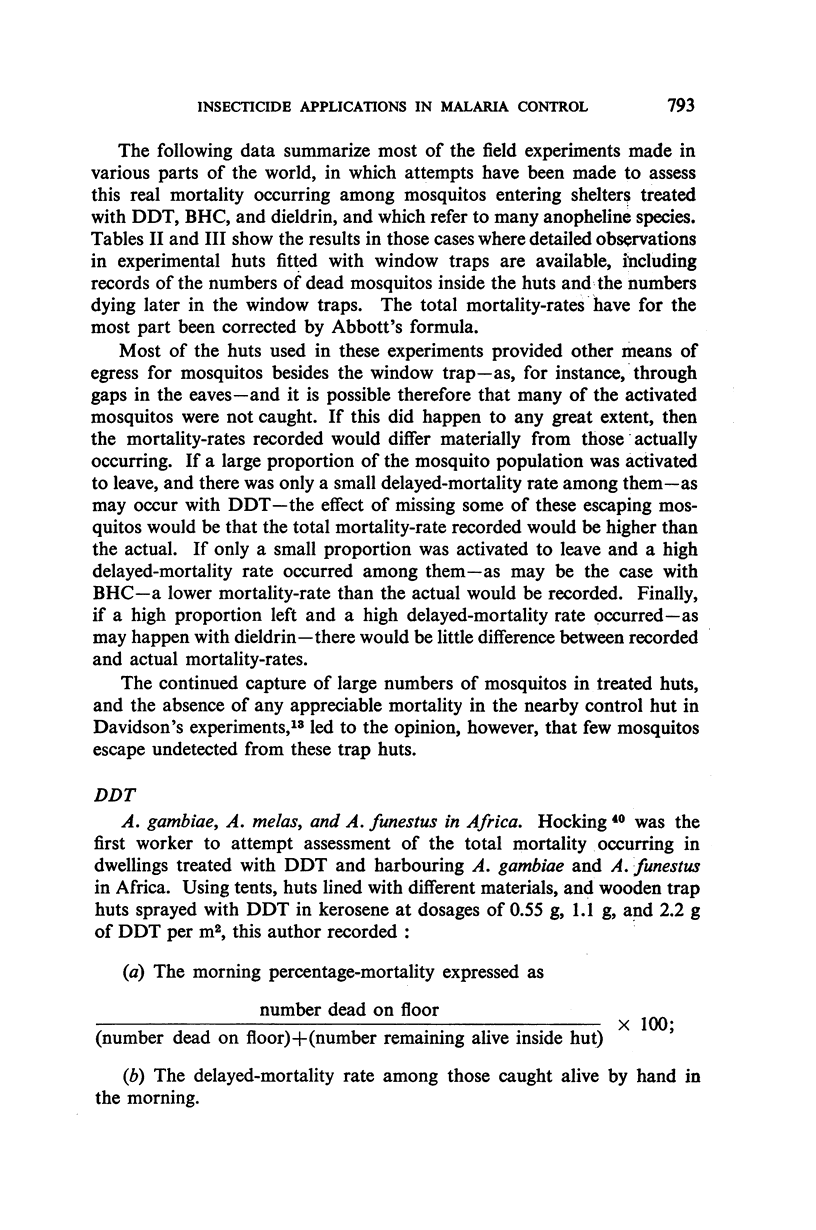
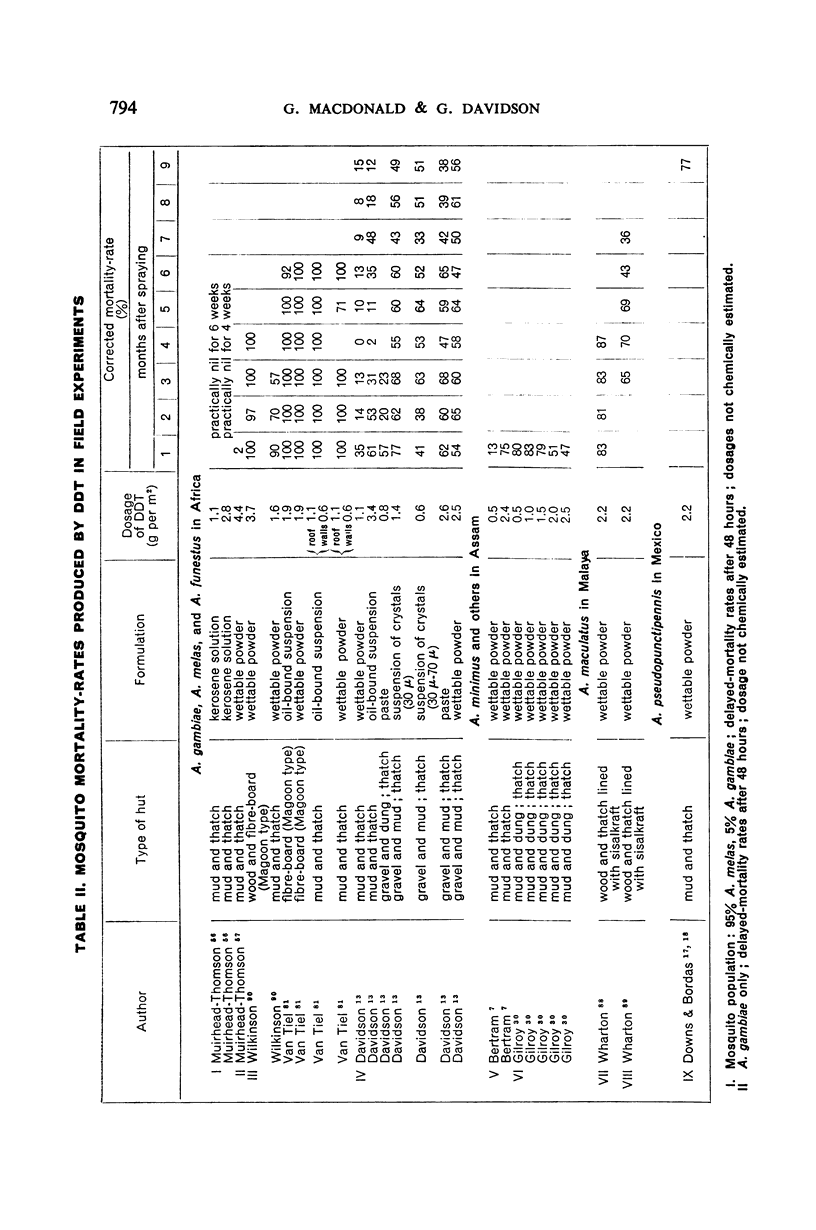
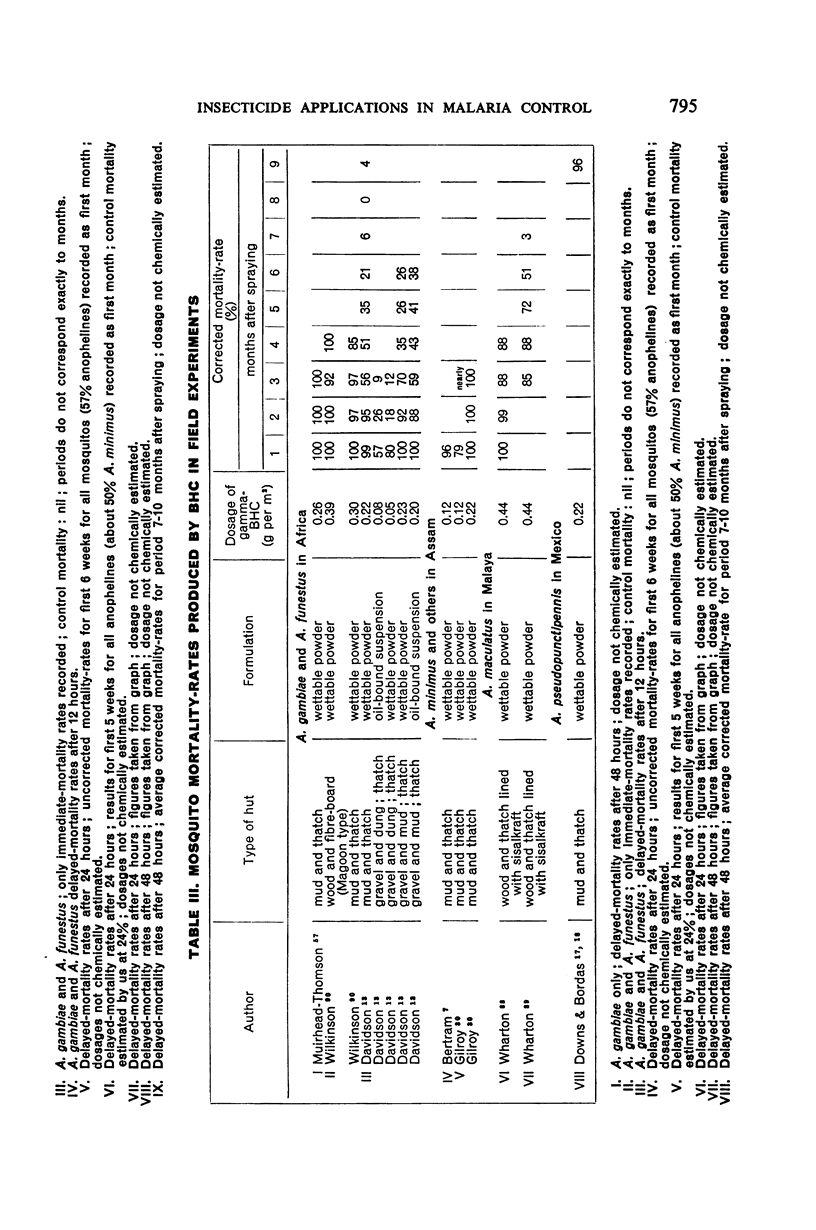
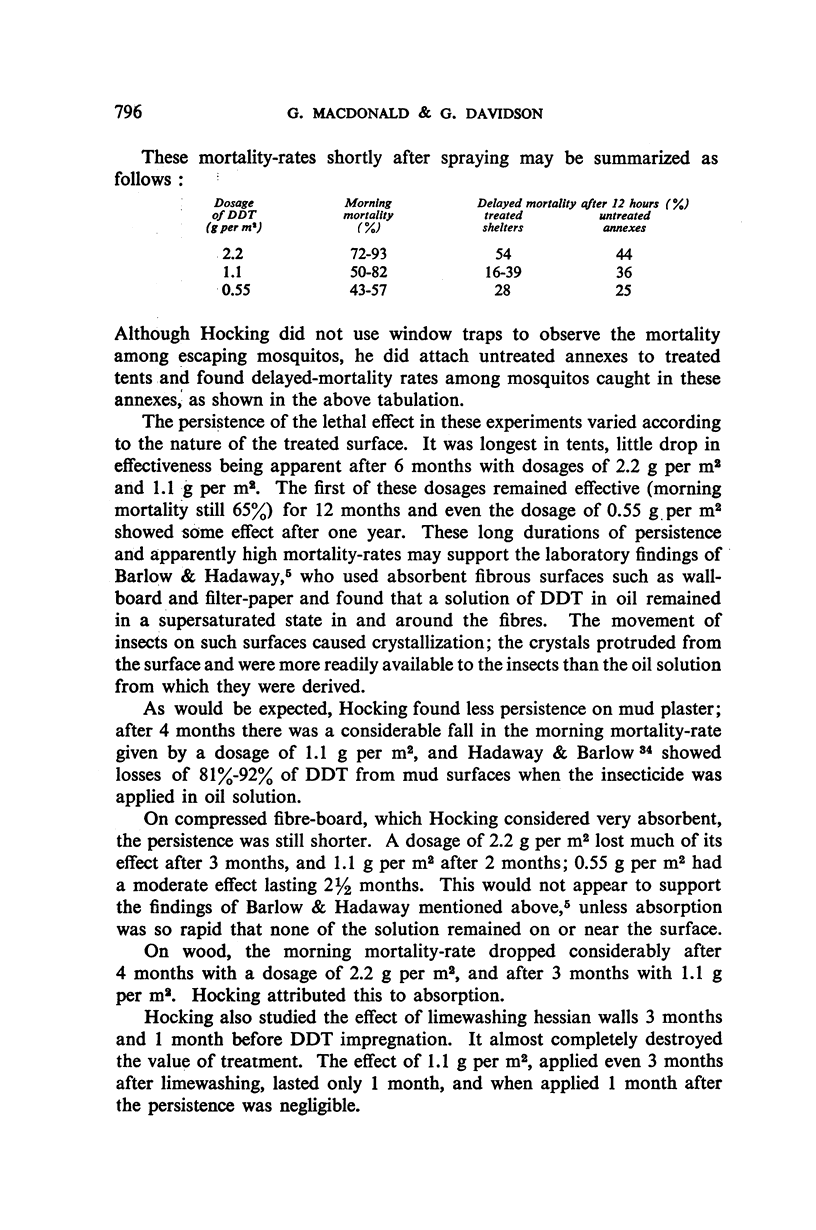
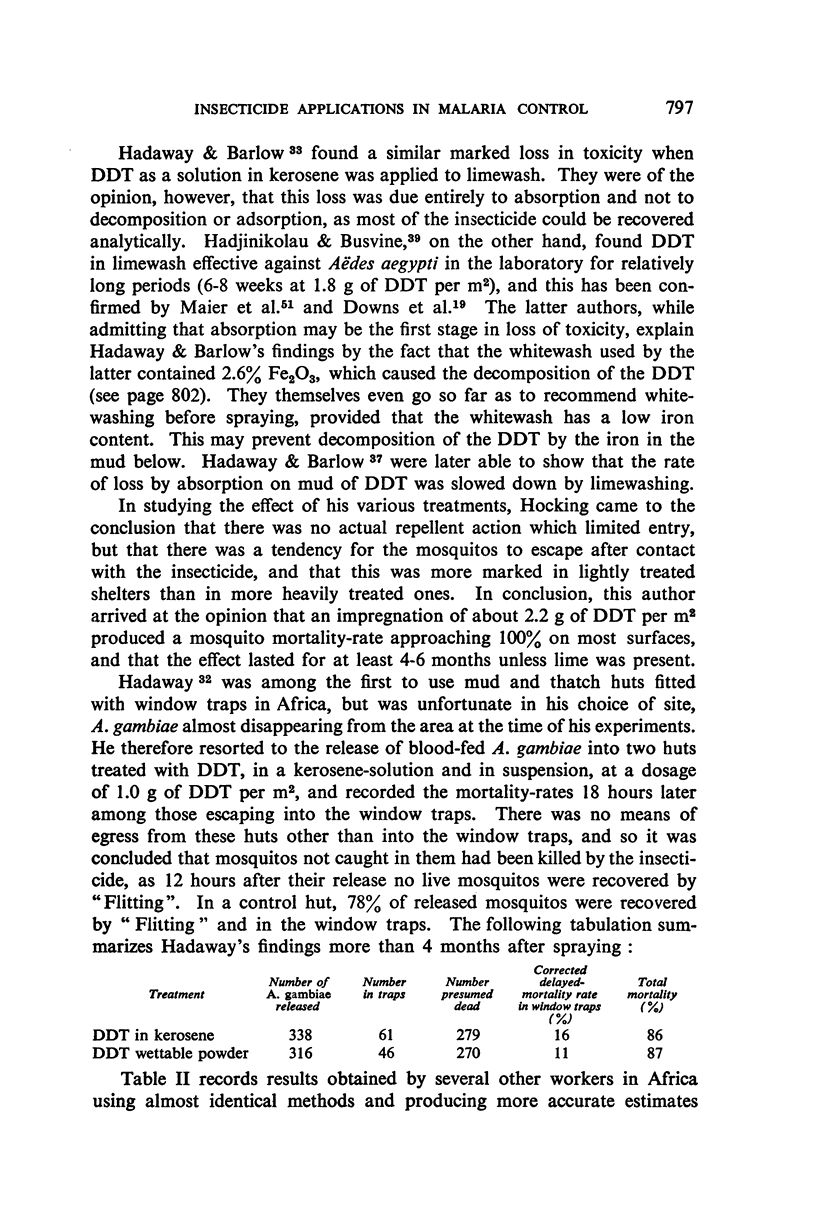
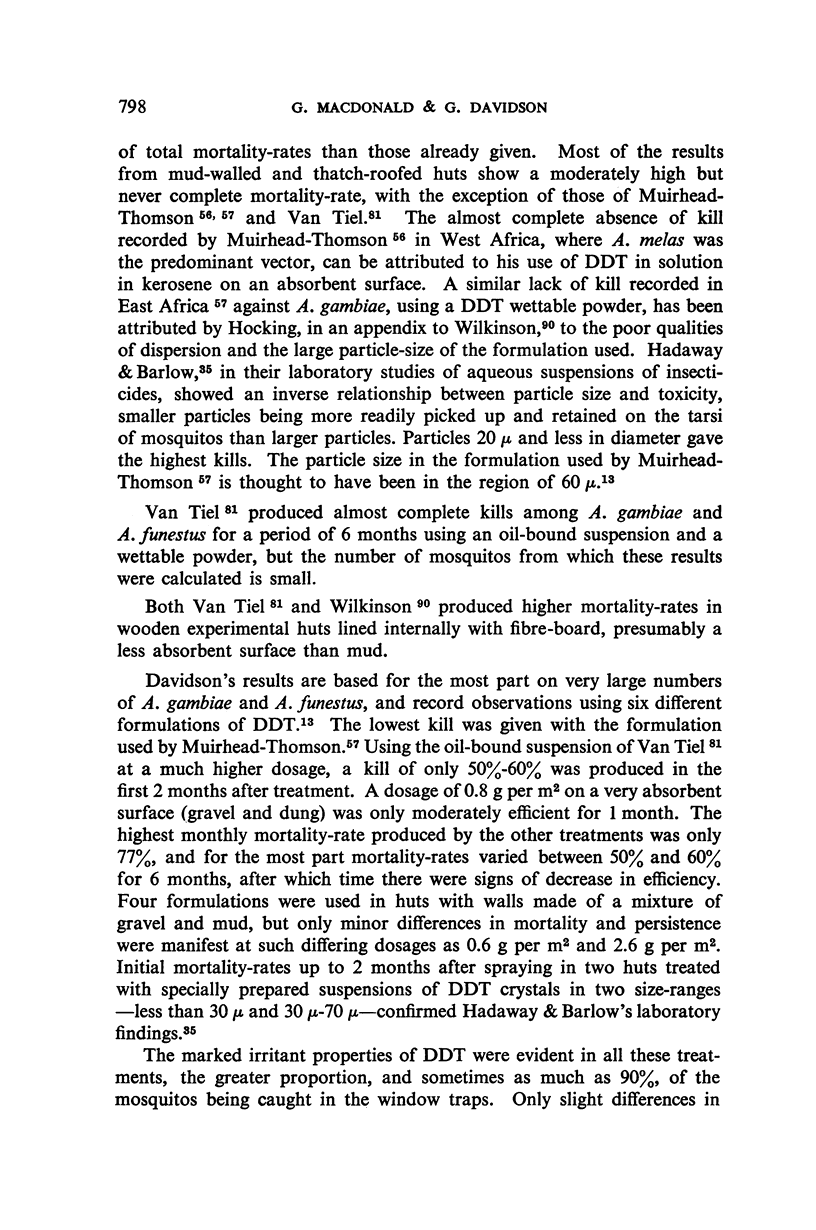
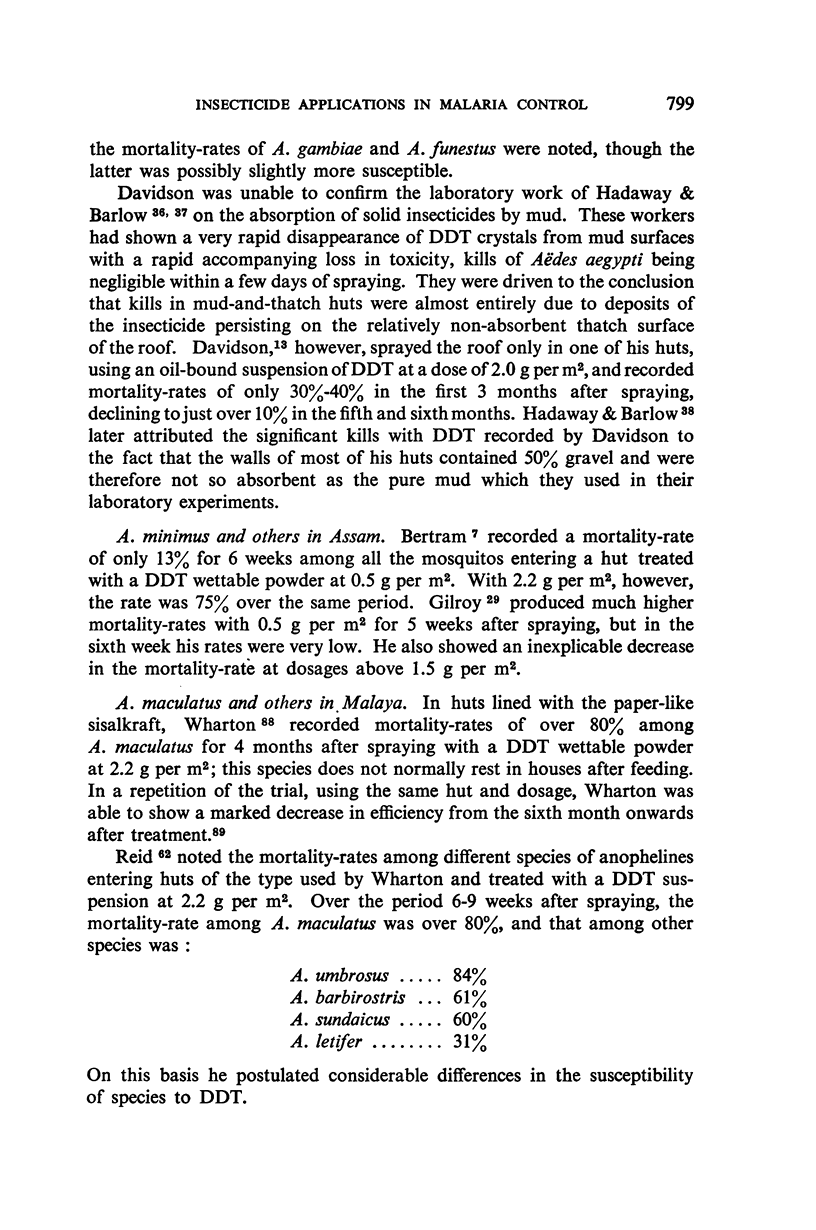
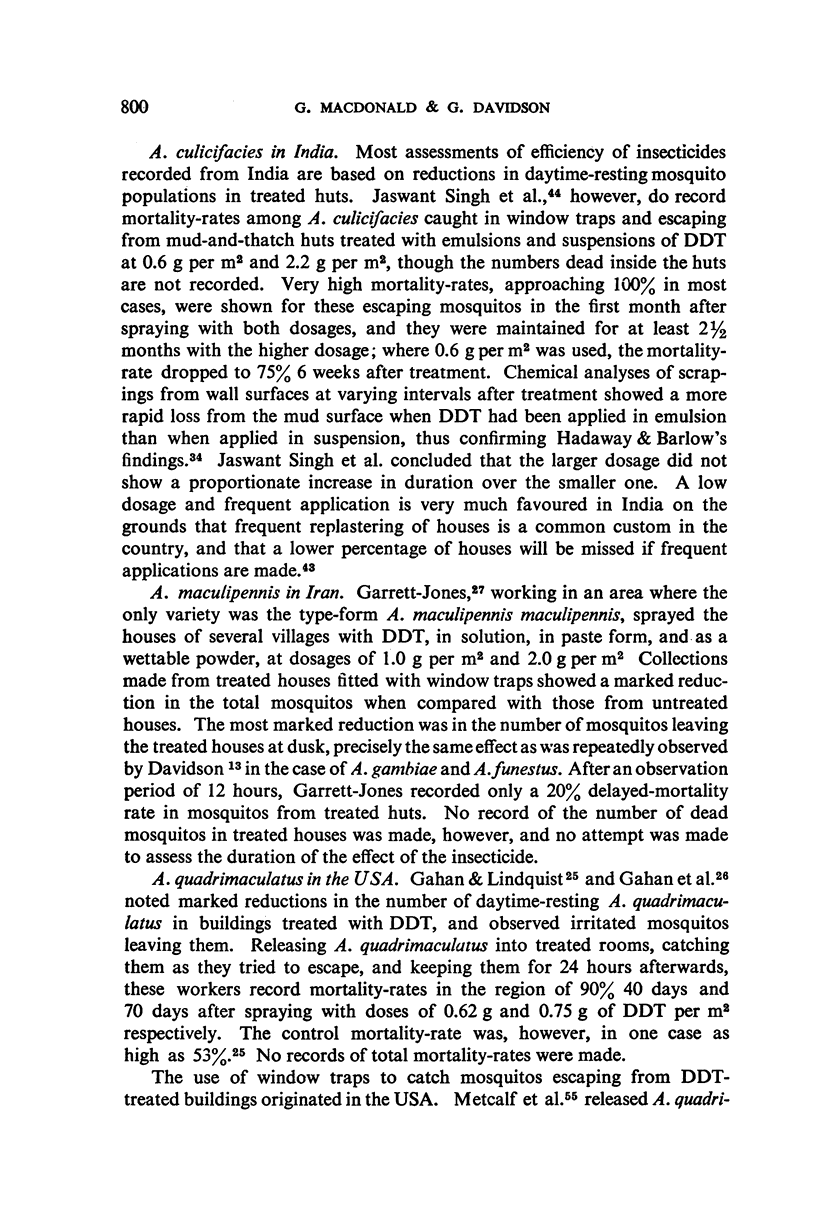
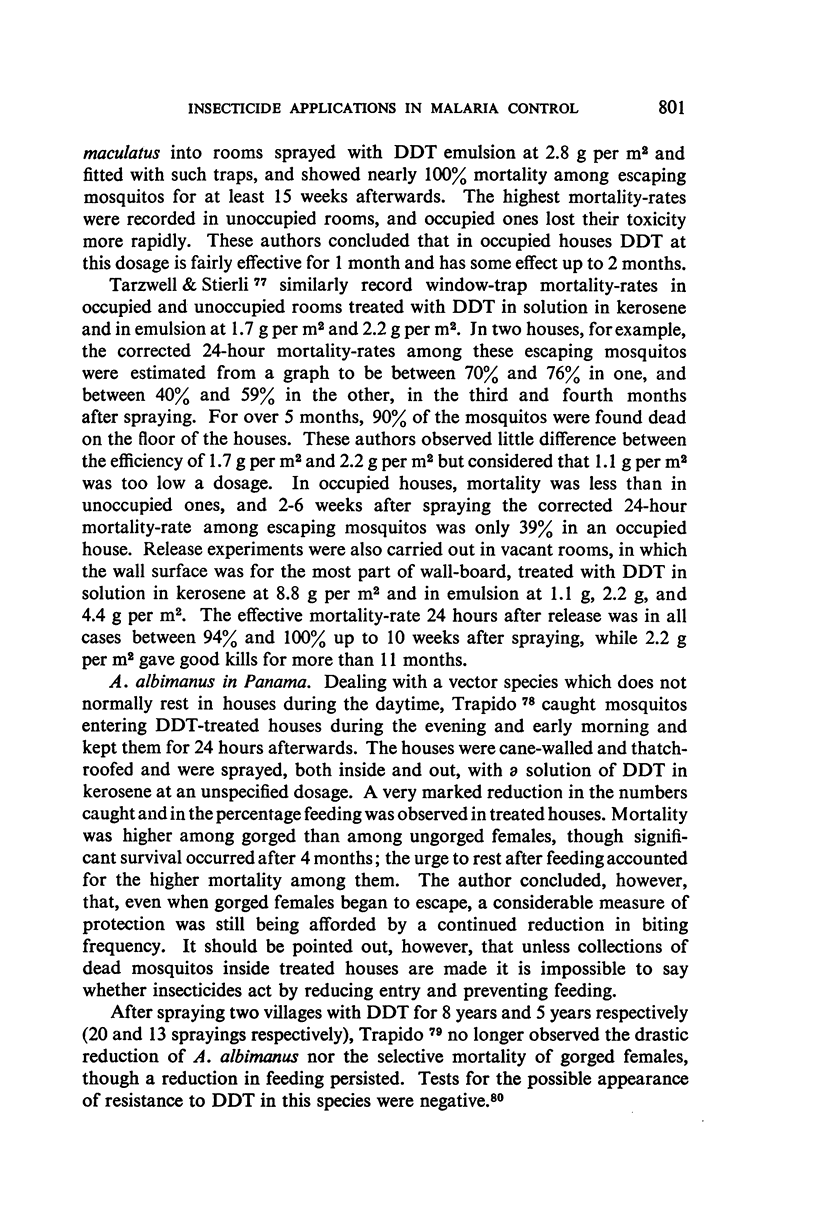
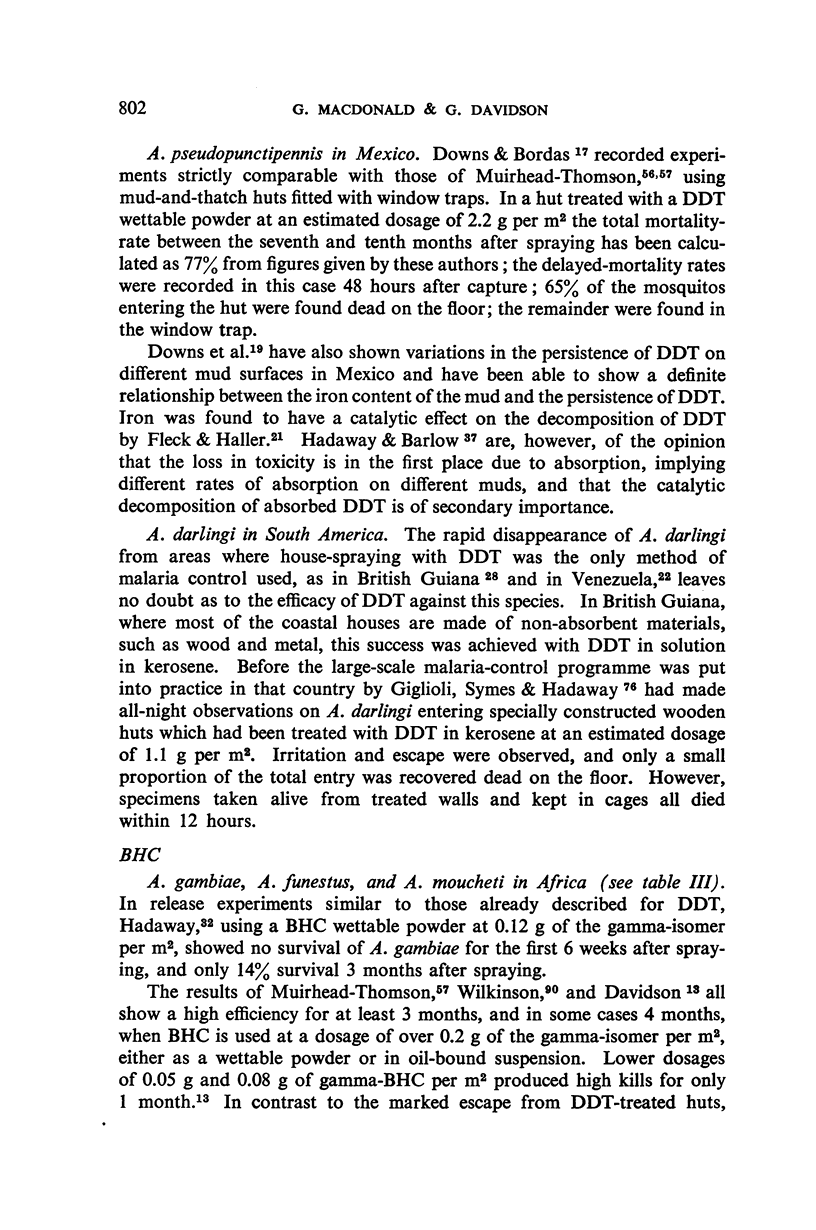
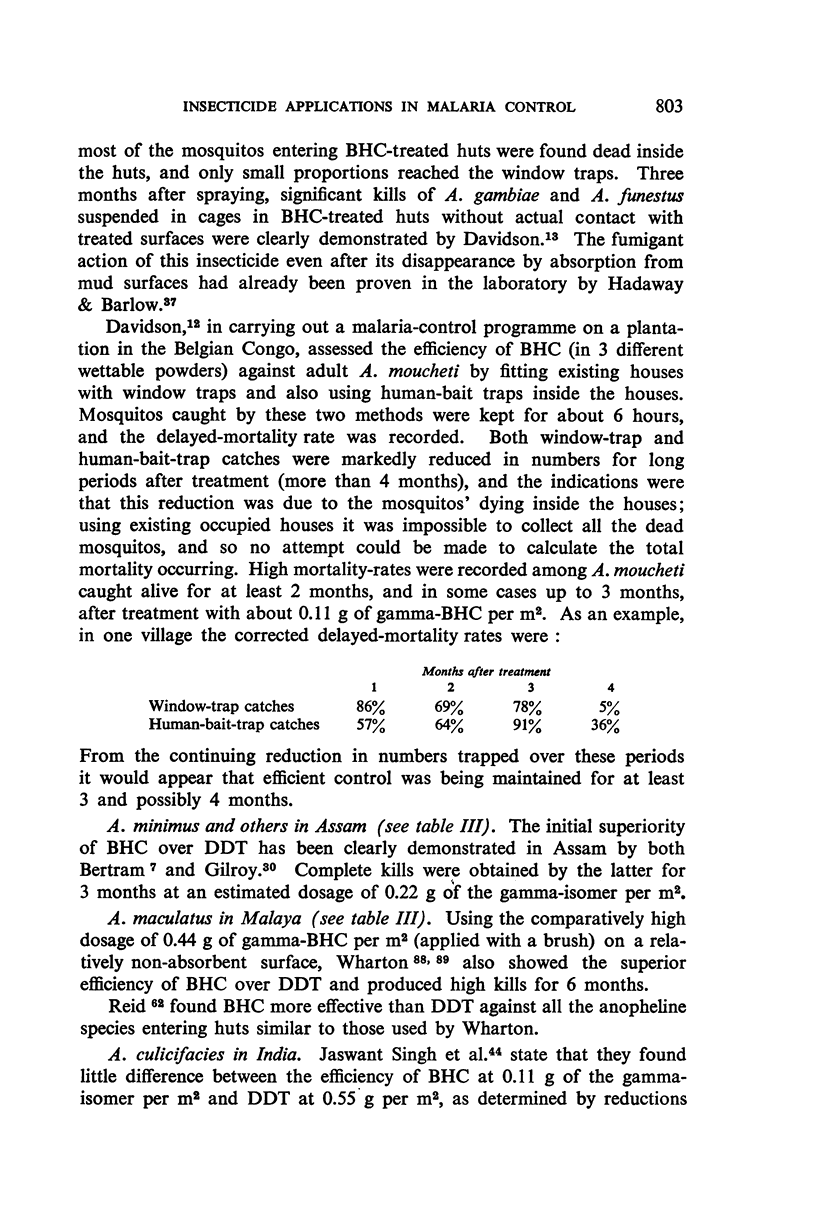
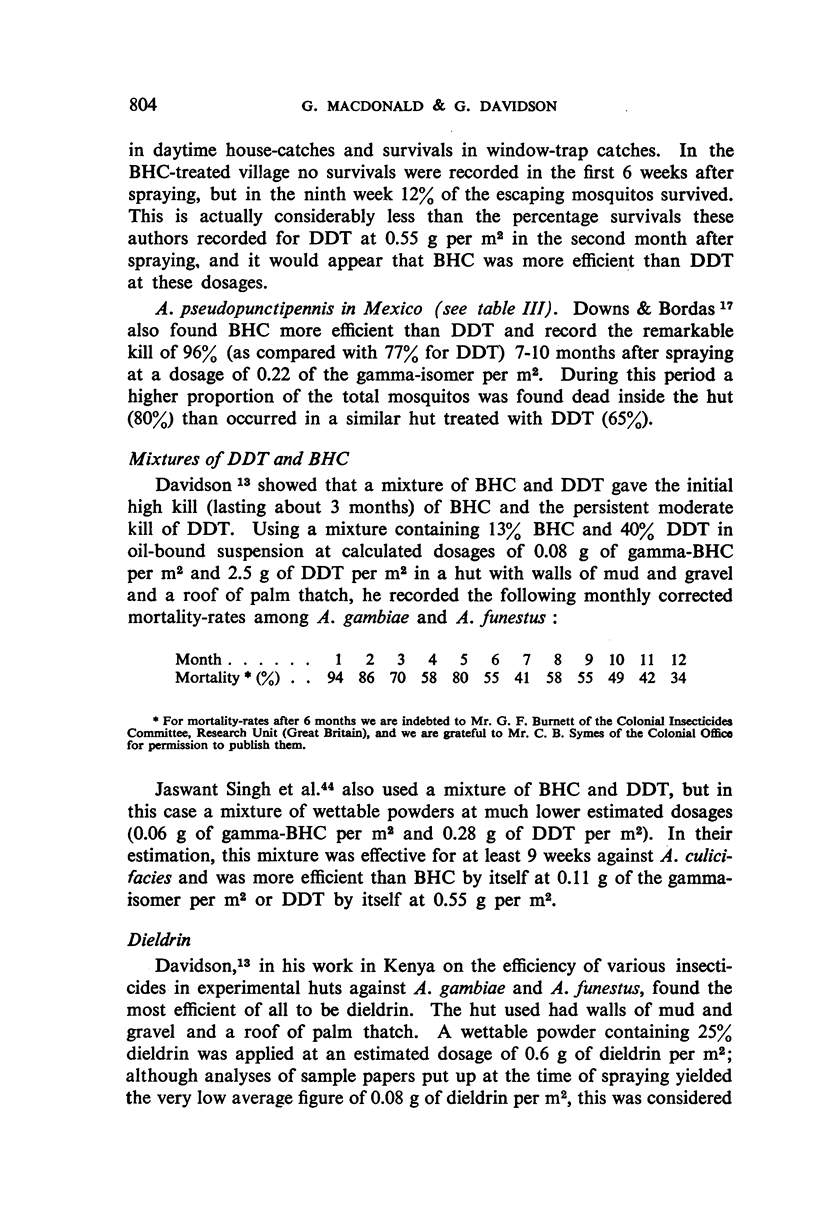
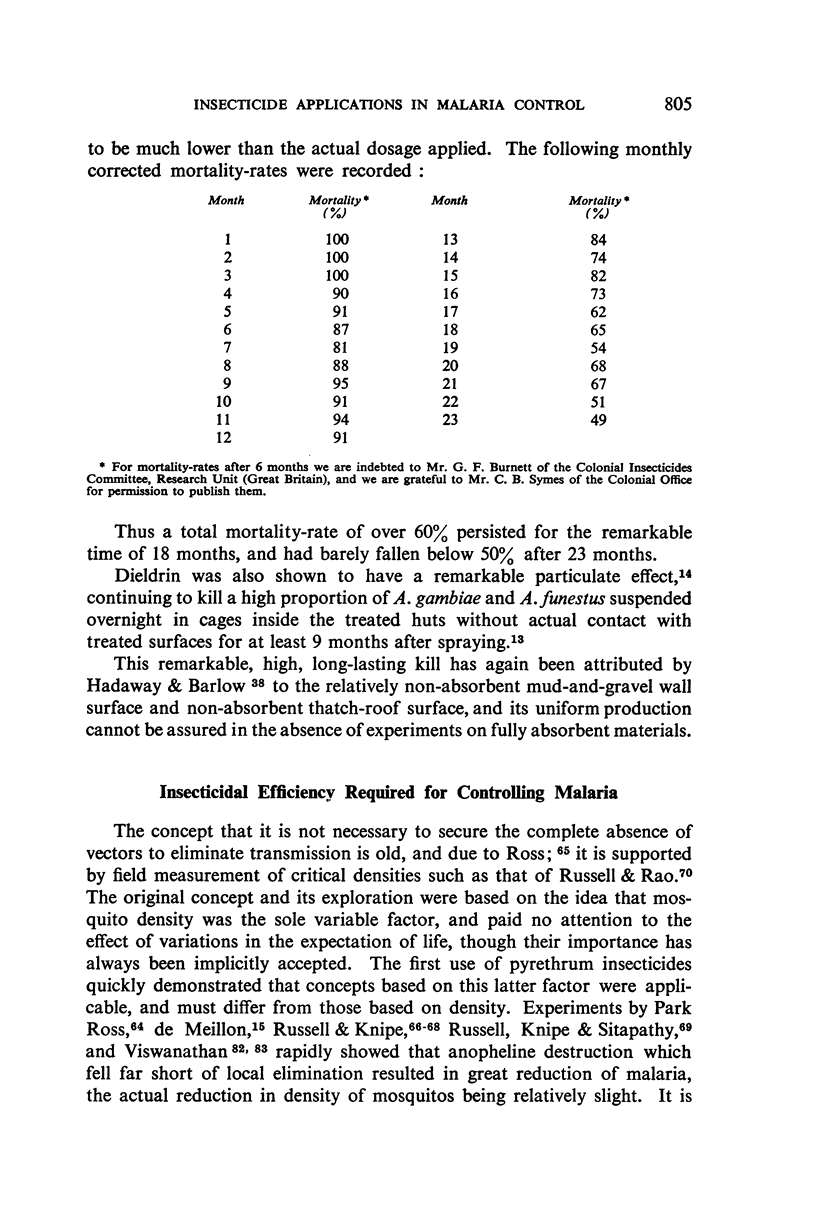
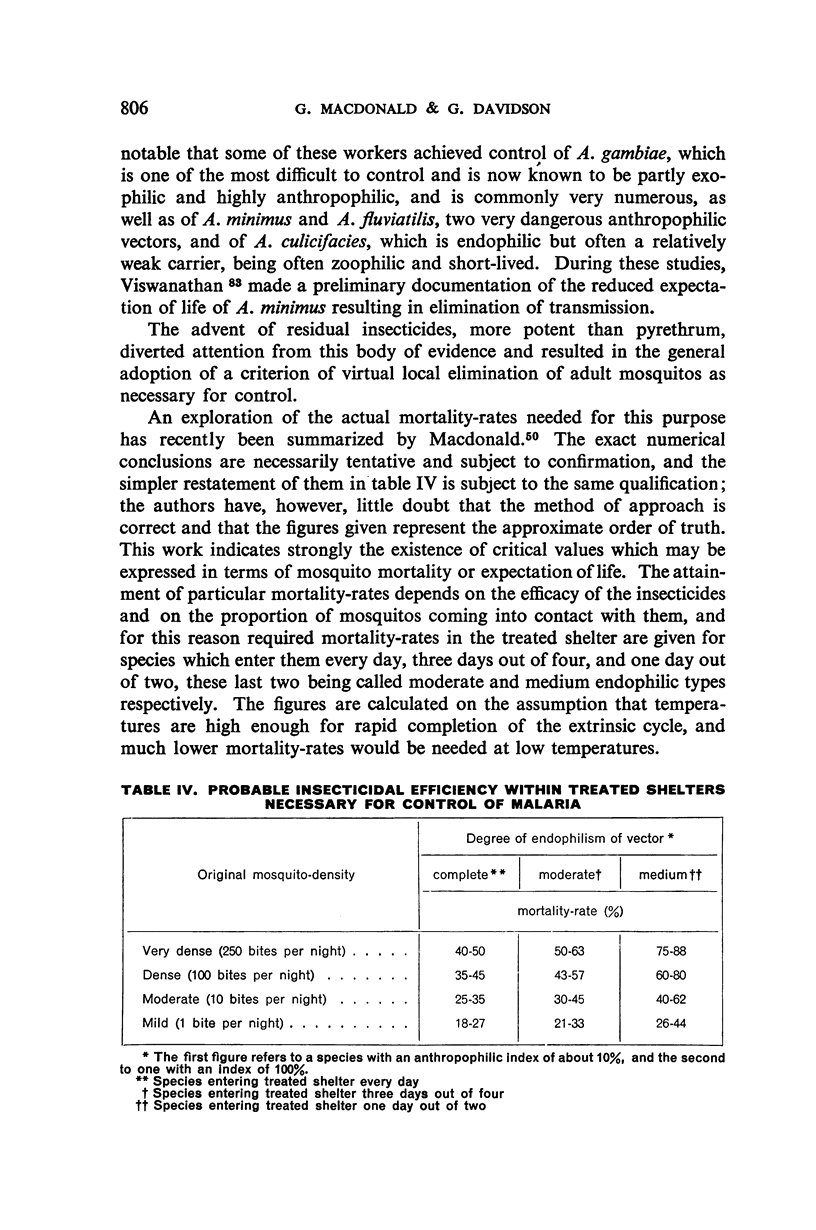
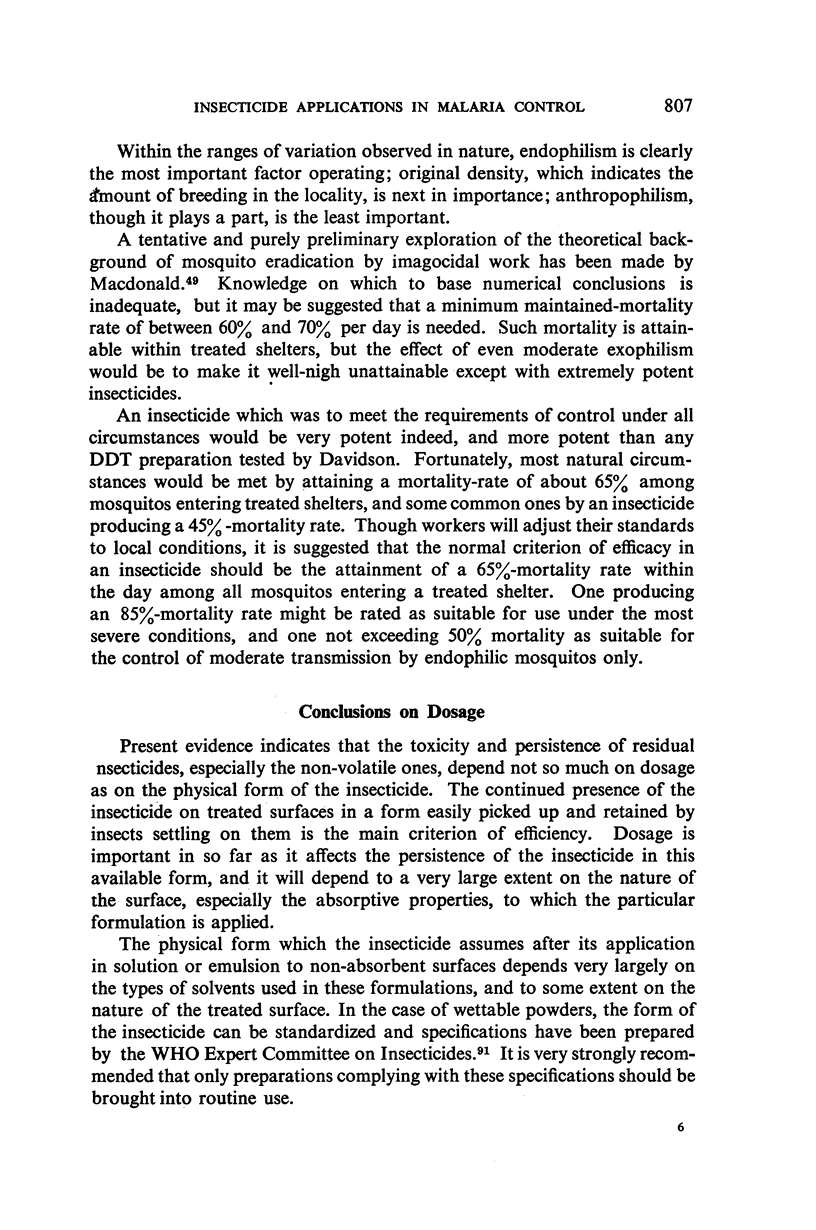
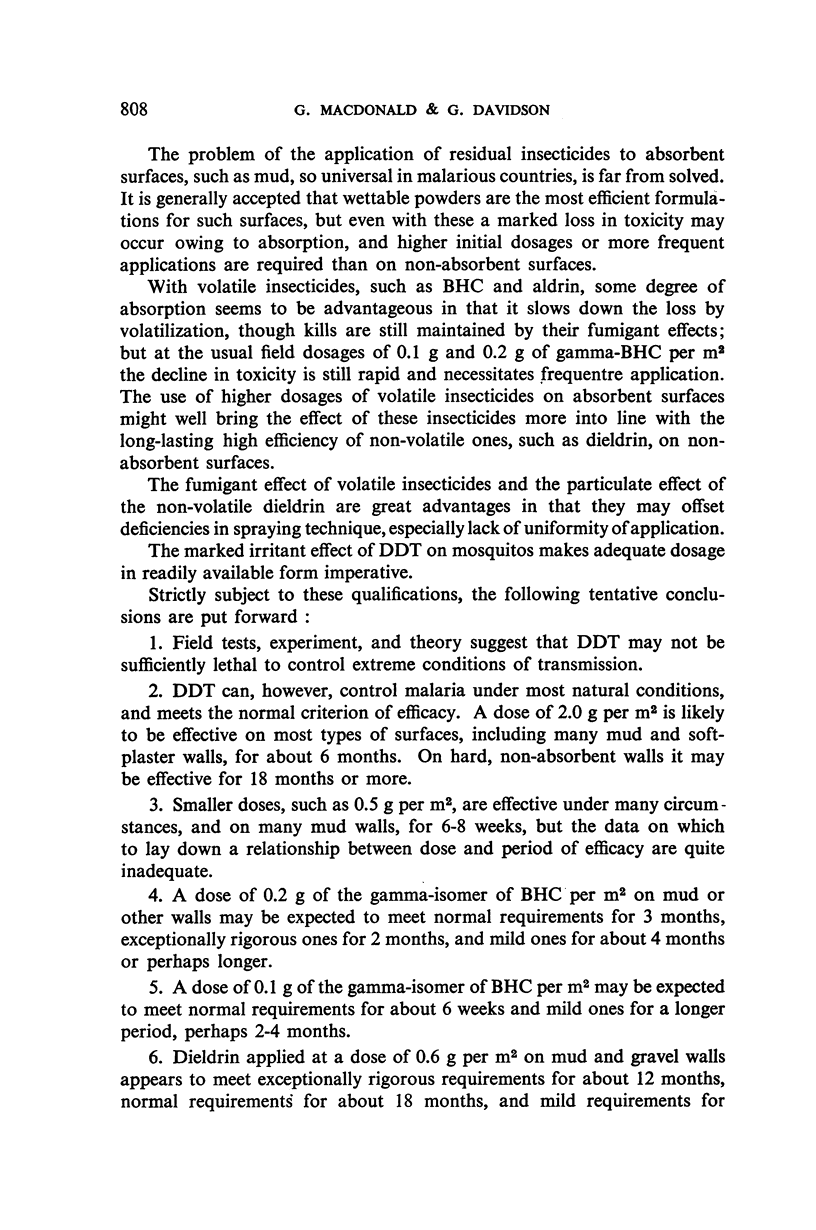

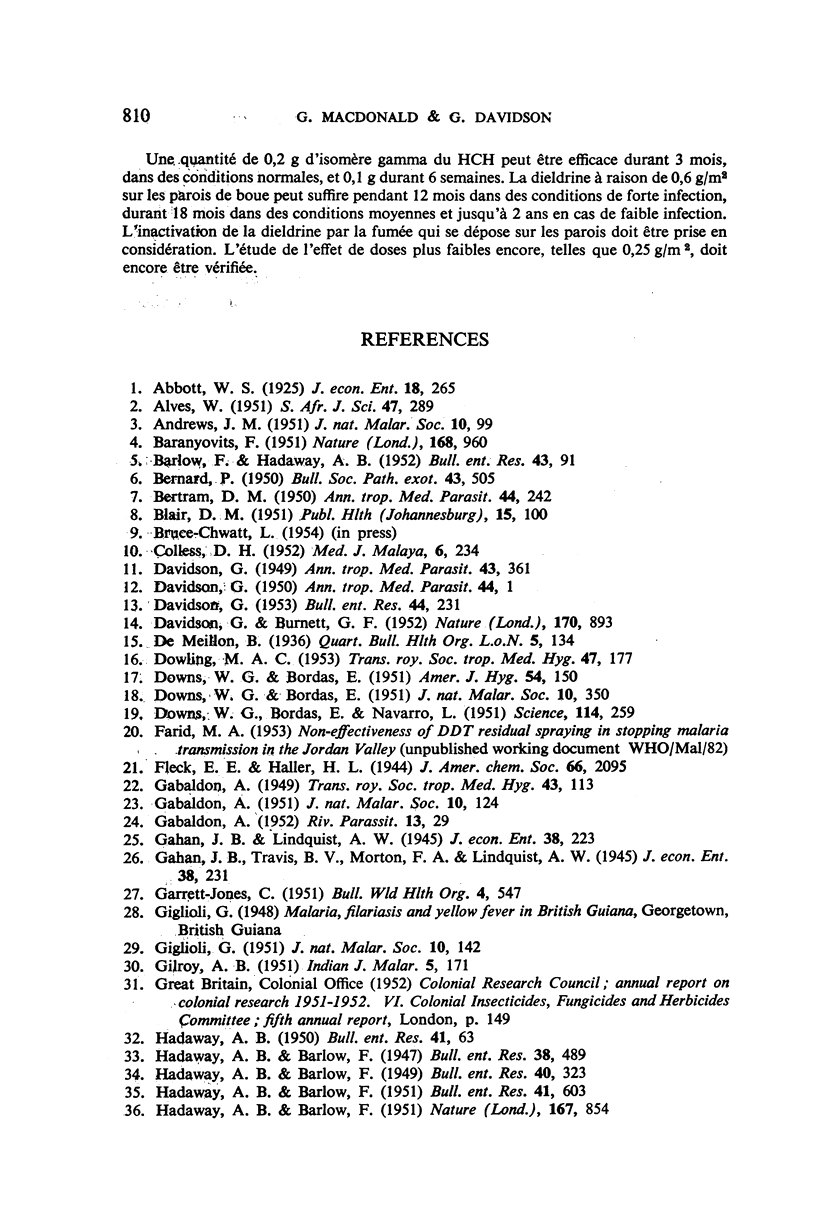
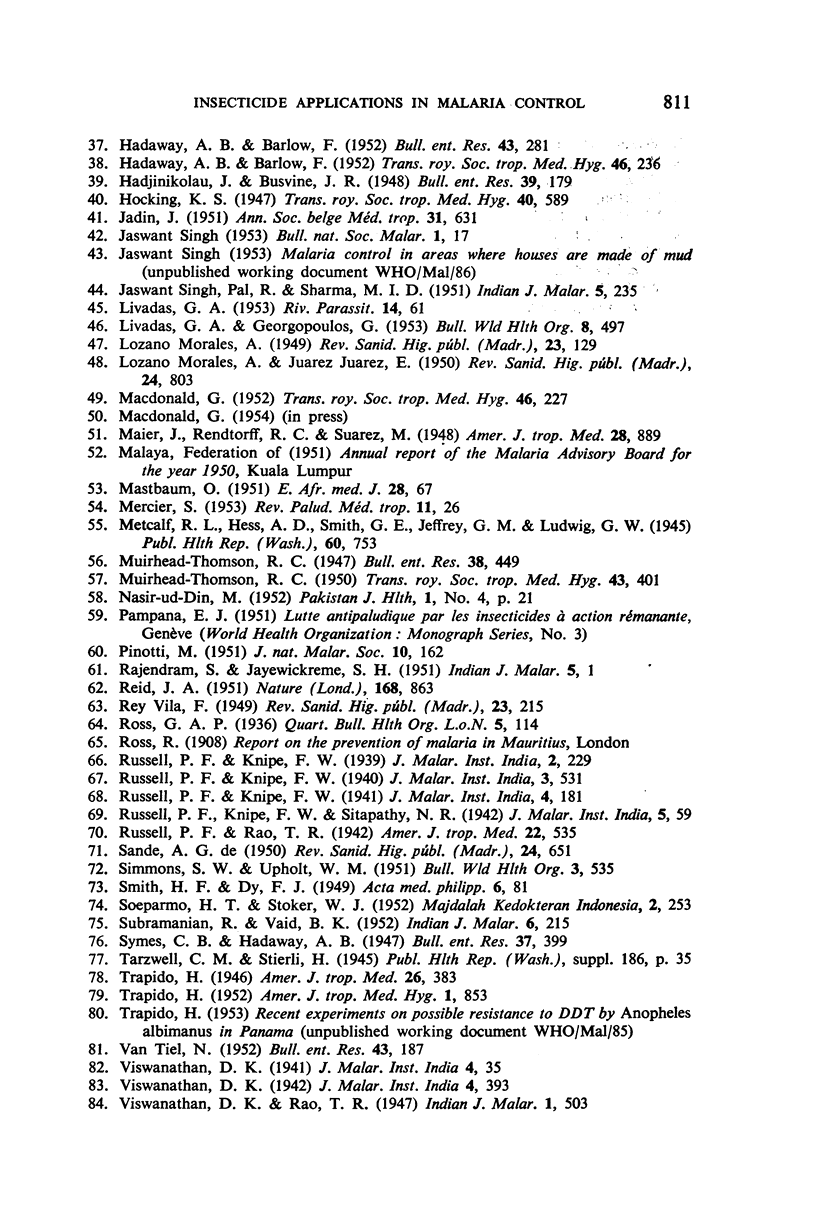
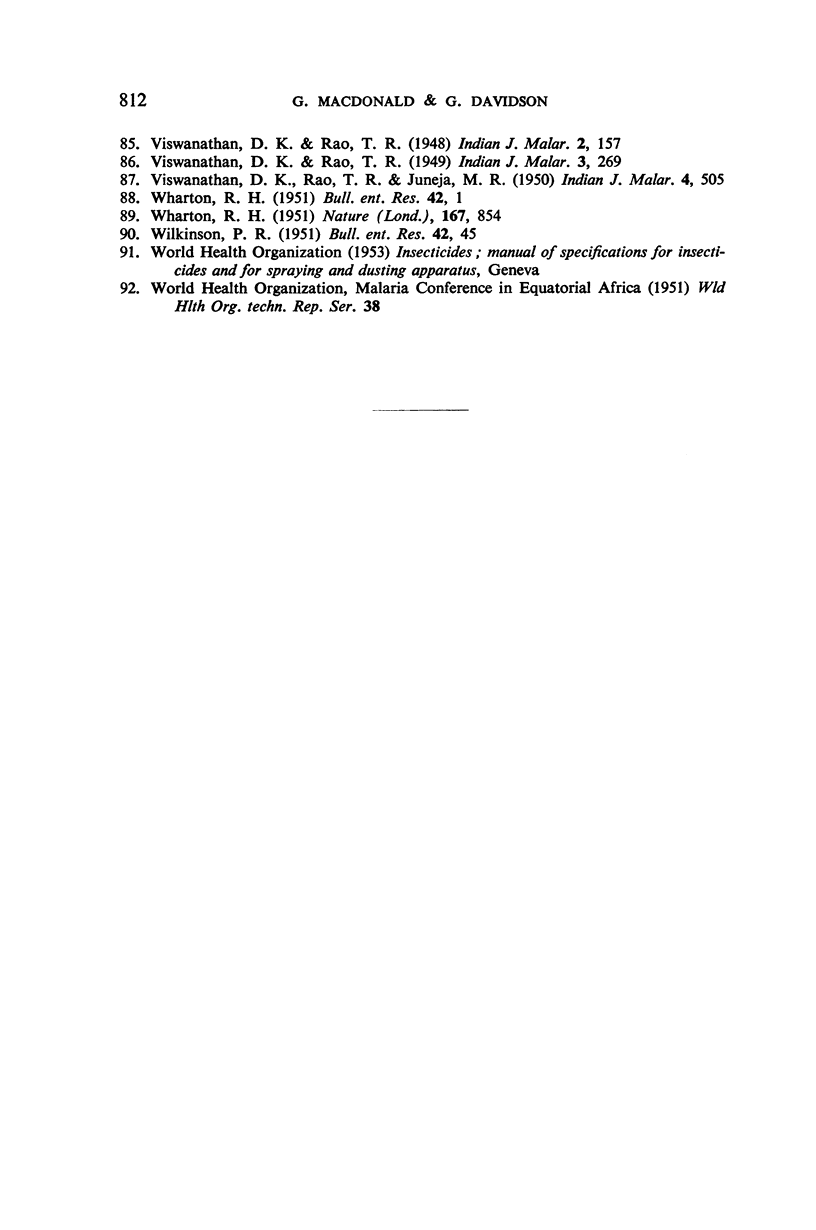
Selected References
These references are in PubMed. This may not be the complete list of references from this article.
- BARANYOVITIS F. Fly reactions to insecticidal deposits; a new test technique. Nature. 1951 Dec 1;168(4283):960–961. [PubMed] [Google Scholar]
- DAVIDSON G. A field study on gammexane and malaria control in the Belgian Congo; the anophelines of Yaligimba and their bionomics. Ann Trop Med Parasitol. 1949 Dec;43(3-4):361–372. doi: 10.1080/00034983.1949.11685422. [DOI] [PubMed] [Google Scholar]
- DAVIDSON G., BURNETT G. F. Apparent fumigant action of non-volatile insecticides in African huts. Nature. 1952 Nov 22;170(4334):893–893. doi: 10.1038/170893a0. [DOI] [PubMed] [Google Scholar]
- DOWNS W. G., BORDAS E. Anopheles aztecus, malaria, and malaria control in the Valley of Mexico. J Natl Malar Soc. 1951 Dec;10(4):350–358. [PubMed] [Google Scholar]
- DOWNS W. G., BORDAS E. Control of Anopheles pseudopunctipennis in Mexico with DDT residual sprays applied in buildings. Part V. Effectiveness of residual applications of DDT and gammexane up to one year after application under controlled conditions. Am J Hyg. 1951 Jul;54(1):150–156. doi: 10.1093/oxfordjournals.aje.a119466. [DOI] [PubMed] [Google Scholar]
- DOWNS W. G., BORDAS E., NAVARRO L. Duration of action of residual DDT deposits on adobe surfaces. Science. 1951 Sep 7;114(2958):259–262. doi: 10.1126/science.114.2958.259. [DOI] [PubMed] [Google Scholar]
- GABALDON A. Nation-wide malaria eradication projects in the Americas. II. Progress of the malaria campaign in Venezuela. J Natl Malar Soc. 1951 Jun;10(2):124–141. [PubMed] [Google Scholar]
- GABALDON A. The nation-wide campaign against malaria in Venezuela. Trans R Soc Trop Med Hyg. 1949 Sep;43(2):113–164. doi: 10.1016/0035-9203(49)90037-1. [DOI] [PubMed] [Google Scholar]
- GARRETT-JONES C. An experiment in trapping and controlling Anopheles maculipennis in North Iran. Bull World Health Organ. 1951;4(4):547–562. [PMC free article] [PubMed] [Google Scholar]
- GIGLIOLI G. Nation-wide malaria eradication projects in the Americas. III. Eradication of Anopheles darlingi from the inhabited areas of British Guiana by DDT residual spraying. J Natl Malar Soc. 1951 Jun;10(2):142–161. [PubMed] [Google Scholar]
- GIMENO de SANDE A. Campaña profiláctica antipalúdica con gammaexano en Motril, durante el año 1949. Rev Sanid Hig Publica (Madr) 1950 Sep;24(9):651–658. [PubMed] [Google Scholar]
- HADAWAY A. B., BARLOW F. Further studies on the loss of insecticides by absorption into mud and vegetation. Bull Entomol Res. 1949 Dec;40(3):323–343. doi: 10.1017/s0007485300022793. [DOI] [PubMed] [Google Scholar]
- HADAWAY A. B., BARLOW F. Some physical factors affecting the efficiency of insecticides. Trans R Soc Trop Med Hyg. 1952 May;46(3):236–244. doi: 10.1016/0035-9203(52)90071-0. [DOI] [PubMed] [Google Scholar]
- HADAWAY A. B., BARLOW F. Sorption of solid insecticides by dried mud. Nature. 1951 May 26;167(4256):854–854. doi: 10.1038/167854a0. [DOI] [PubMed] [Google Scholar]
- JADIN J. Rapport sur la campagne de dédetisation. Ann Soc Belg Med Trop (1920) 1951 Dec;31(6):631–651. [PubMed] [Google Scholar]
- LIVADAS G. A., GEORGOPOULOS G. Development of resistance to DDT by Anopheles sacharovi in Greece. Bull World Health Organ. 1953;8(4):497–511. [PMC free article] [PubMed] [Google Scholar]
- LOZANO MORALES A., JUAREZ JUAREZ E. Consideraciones sobre una campaña de pulverizaciones residuales de la zona palúdica del räo Tiétar (Cáceres). Rev Sanid Hig Publica (Madr) 1950 Nov-Dec;24(11-12):803–816. [PubMed] [Google Scholar]
- MACDONALD G. The objectives of residual insecticide campaigns. Trans R Soc Trop Med Hyg. 1952 May;46(3):227–235. doi: 10.1016/0035-9203(52)90070-9. [DOI] [PubMed] [Google Scholar]
- MAIER J., RENDTORFF R. C., SUAREZ M. The duration of residual effect of DDT sprays on building materials used in rural Venezuela. Am J Trop Med Hyg. 1948 Nov;28(6):889–894. doi: 10.4269/ajtmh.1948.s1-28.889. [DOI] [PubMed] [Google Scholar]
- MASTBAUM O. Field experiments with D.D.T. emulsion and wettable D.D.T. with special reference to malaria incidence in Swaziland during the transmission season 1949/50. East Afr Med J. 1951 Feb;28(2):67–74. [PubMed] [Google Scholar]
- MUIRHEAD-THOMSON R. C. DDT and gammexane as residual insecticides against Anopheles gambiae in African houses. Trans R Soc Trop Med Hyg. 1950 Jan;43(4):401–412. doi: 10.1016/0035-9203(50)90036-8. [DOI] [PubMed] [Google Scholar]
- PINOTTI M. Nation-wide malaria eradication projects in the Americas. IV. The nation-wide malaria eradication program in Brazil. J Natl Malar Soc. 1951 Jun;10(2):162–182. [PubMed] [Google Scholar]
- RAJENDRAM S., JAYEWICKREME S. H. Malaria in Ceylon. Part I. The control and prevention of epidemic malaria by the residual spraying of houses with D.D.T. Indian J Malariol. 1951 Mar;5(1):1–73. [PubMed] [Google Scholar]
- REID J. A. Effects of DDT upon different species of mosquitoes in Malaya. Nature. 1951 Nov 17;168(4281):863–865. doi: 10.1038/168863a0. [DOI] [PubMed] [Google Scholar]
- REY VILA F. Campanña de lucha antimosquito en la Isla Mayor del Guadalquivir, Sevilla. Rev Sanid. 1949 Mar;23(3):215–249. [PubMed] [Google Scholar]
- SERGE M. La prophylaxie du paludisme à Tananarive en 1951; incidences épidémiologiques et démographiques. Rev Palud Med Trop. 1953 Feb 15;11(104):26–36. [PubMed] [Google Scholar]
- SINGH J., PAL R., SHARMA M. I. D. Field studies on the comparative effectiveness of D.D.T. and B.H.C. against mosquitoes when applied separately and in combination. Indian J Malariol. 1951 Jun;5(2):235–248. [PubMed] [Google Scholar]
- SUBRAMANIAN R., VAID B. K. Some observations on rural malaria control using residual insecticides in wettable powder form. Indian J Malariol. 1952 Jun;6(2):215–218. [PubMed] [Google Scholar]
- TRAPIDO H. Modified response of Anopheles albimanus to DDT residual house spraying in Panama. Am J Trop Med Hyg. 1952 Sep;1(5):853–861. doi: 10.4269/ajtmh.1952.1.853. [DOI] [PubMed] [Google Scholar]
- VISWANATHAN D. K., RAMACHANDRA RAO T., JUNEJA M. R. Further notes on the use of benzene hexachloride as a residual insecticide compared with dichloro-diphenyl-trichloroethane. Indian J Malariol. 1950 Dec;4(4):505–531. [PubMed] [Google Scholar]
- WHARTON R. H. DDT and BHC as residual insecticides in Malaya. Nature. 1951 May 26;167(4256):854–855. doi: 10.1038/167854b0. [DOI] [PubMed] [Google Scholar]


